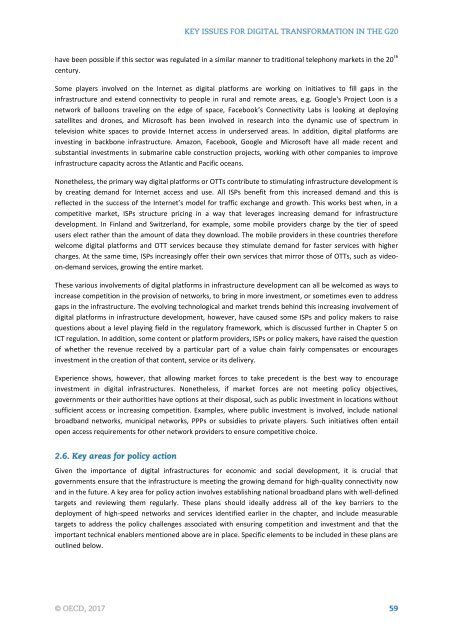KEY ISSUES FOR DIGITAL TRANSFORMATION IN THE G20
2jz0oUm
2jz0oUm
Create successful ePaper yourself
Turn your PDF publications into a flip-book with our unique Google optimized e-Paper software.
have been possible if this sector was regulated in a similar manner to traditional telephony markets in the 20 th<br />
century.<br />
Some players involved on the Internet as digital platforms are working on initiatives to fill gaps in the<br />
infrastructure and extend connectivity to people in rural and remote areas, e.g. Google's Project Loon is a<br />
network of balloons traveling on the edge of space, Facebook’s Connectivity Labs is looking at deploying<br />
satellites and drones, and Microsoft has been involved in research into the dynamic use of spectrum in<br />
television white spaces to provide Internet access in underserved areas. In addition, digital platforms are<br />
investing in backbone infrastructure. Amazon, Facebook, Google and Microsoft have all made recent and<br />
substantial investments in submarine cable construction projects, working with other companies to improve<br />
infrastructure capacity across the Atlantic and Pacific oceans.<br />
Nonetheless, the primary way digital platforms or OTTs contribute to stimulating infrastructure development is<br />
by creating demand for Internet access and use. All ISPs benefit from this increased demand and this is<br />
reflected in the success of the Internet’s model for traffic exchange and growth. This works best when, in a<br />
competitive market, ISPs structure pricing in a way that leverages increasing demand for infrastructure<br />
development. In Finland and Switzerland, for example, some mobile providers charge by the tier of speed<br />
users elect rather than the amount of data they download. The mobile providers in these countries therefore<br />
welcome digital platforms and OTT services because they stimulate demand for faster services with higher<br />
charges. At the same time, ISPs increasingly offer their own services that mirror those of OTTs, such as videoon-demand<br />
services, growing the entire market.<br />
These various involvements of digital platforms in infrastructure development can all be welcomed as ways to<br />
increase competition in the provision of networks, to bring in more investment, or sometimes even to address<br />
gaps in the infrastructure. The evolving technological and market trends behind this increasing involvement of<br />
digital platforms in infrastructure development, however, have caused some ISPs and policy makers to raise<br />
questions about a level playing field in the regulatory framework, which is discussed further in Chapter 5 on<br />
ICT regulation. In addition, some content or platform providers, ISPs or policy makers, have raised the question<br />
of whether the revenue received by a particular part of a value chain fairly compensates or encourages<br />
investment in the creation of that content, service or its delivery.<br />
Experience shows, however, that allowing market forces to take precedent is the best way to encourage<br />
investment in digital infrastructures. Nonetheless, if market forces are not meeting policy objectives,<br />
governments or their authorities have options at their disposal, such as public investment in locations without<br />
sufficient access or increasing competition. Examples, where public investment is involved, include national<br />
broadband networks, municipal networks, PPPs or subsidies to private players. Such initiatives often entail<br />
open access requirements for other network providers to ensure competitive choice.<br />
Given the importance of digital infrastructures for economic and social development, it is crucial that<br />
governments ensure that the infrastructure is meeting the growing demand for high-quality connectivity now<br />
and in the future. A key area for policy action involves establishing national broadband plans with well-defined<br />
targets and reviewing them regularly. These plans should ideally address all of the key barriers to the<br />
deployment of high-speed networks and services identified earlier in the chapter, and include measurable<br />
targets to address the policy challenges associated with ensuring competition and investment and that the<br />
important technical enablers mentioned above are in place. Specific elements to be included in these plans are<br />
outlined below.


